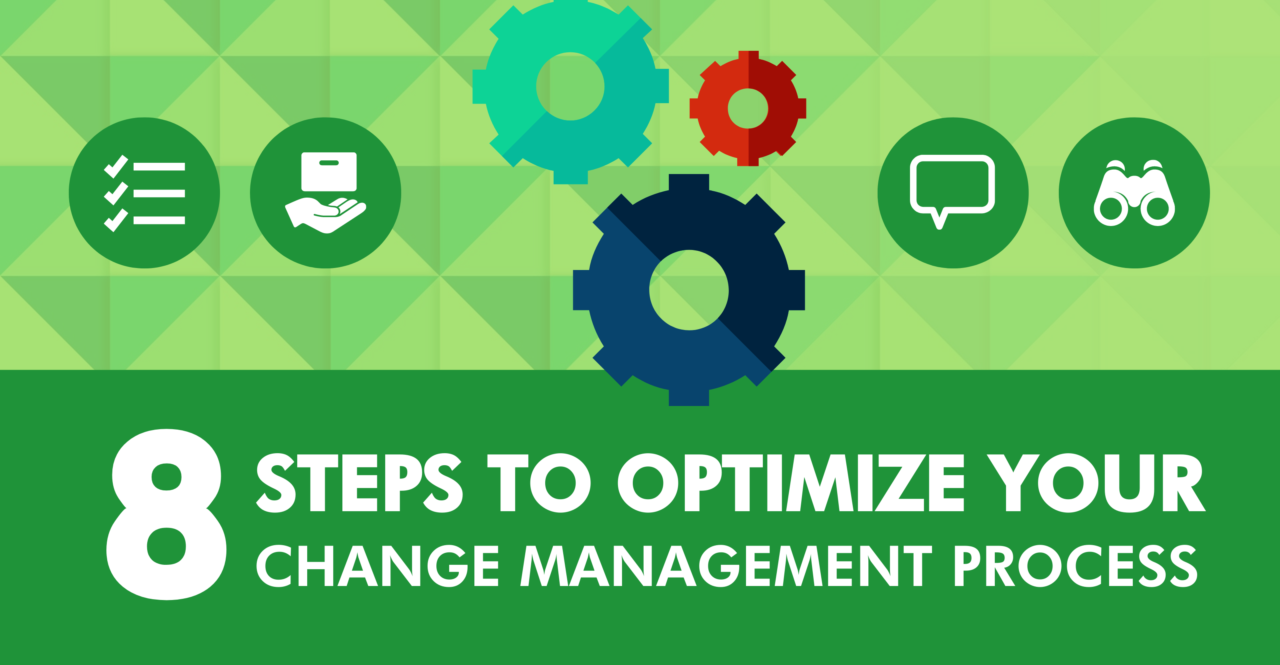
8 Steps to Optimize Your Change Management Process
Companies worldwide are facing an unprecedented number of organizational shifts and changes, being forced to adapt their strategies to meet the newfound demands and overcome the unfamiliar challenges that are arising as a result of the global situation. Because of this, an effective change management process is more critical than ever.
However, change management is not a newfound business strategy unique to this time. Rather, it is a long-standing method of business organization that aims to optimize the efficiency at which changes are implemented within a company. And while change is inevitable in any line of business, but so too is the inevitability of resistance to change. The change management process that exists in your organization is the make-or-break challenge that determines whether you will be able to implement change successfully or not.
What is Change Management and Why Is It Important?
Change management can be defined as the process of managing change and development within a business or similar organization. Change management as a business tool has evolved over the past several years, with models, processes, and plans adapting to help ease the impact that change can have on organizations.
When an organization identifies a need for change, they need to be able to effectively manage the transition period in order to bring about success once the change is implemented. A strong change management process enables companies to better manage necessary or required business-related changes, yielding more successful results as the business evolves.
Every evolving organization understands the importance of consistently improving processes and managing changes that will yield lasting benefits for the business. It is important to recognize the distinction in terminology in order to thoroughly understand how change management can be leveraged to bring about those results. Keep in mind the following distinctions:
- Change Management Processes include a sequence of steps or activities that move a change from inception to delivery.
- Change Management Plans are developed to support a project to deliver change. These are usually developed during the planning stage of the Change Management Process.
Because so many organizations are required to undergo change on a continual basis, a formal set of change management process steps should be a ubiquitous part of management strategy. Working to address the change management needs and initiatives that are unique to your organization is a critical component in future-proofing your business. But where do you begin?
The 8 Critical Change Management Process Steps
Because every business is unique, every change management process will be unique. The goals your organization has, the environment in which your team operates, and the company culture you’ve developed are just some of the factors that make your change management process one-of-a-kind. However, though the specific steps that contribute to the change, the technical details of your approaches, and the people you work with will differ company to company, the broader principles of how to set up an effective change management process remain consistent.
A firm understanding of the change management principles that permeate all types of business will serve as a strong basis for any change management plan. Whether change is caused by new technology, process updates, compliance initiatives, reorganization, customer service improvements, or something else entirely, change is a constant and is necessary for an organization’s growth and profitability. A consistent change management process can help minimize the impact change has on your organization and workforce.
Below you will find 8 essential steps to ensure your change management process is successful.
1. Begin with the Objective
Before you begin any journey, you need to have a destination in mind. This extends to change management planning. When gearing up for change in a company, you need to have a clear understanding of where you are now, and where you are aiming to end up. Make sure to define this goal endpoint as specifically as you can, because a clear understanding of the destination can help in your efforts to have the rest of the organization buy-in on your vision.
It is important to ensure that the change you are aiming to implement aligns with the company’s present mission, and its future vision. An organizations mission statement can evolve over time, so when you’re contemplating a radical change for the business, revisit the existing vision and mission statements first. Small changes, though they may not have as large of an impact, should also align with the existing business objectives, serving to bolster the credibility of your strategic focus.
2. Sell the Need for Change to Management
Once you have a strong idea of what it is you want to change, and why that change is necessary, you need your workforce to want that change just as much as you do. Getting people on board is a critical, and sometimes very difficult, effort, that should be grounded in two-way communication.
Clearly identify the “threat” you are hoping the change will address and remedy, or the opportunity that the change can enable the company to explore and ask for input. Getting different perspectives on the need for change not only makes your team feel more involved and engaged in the change planning process but can also reveal any gaps in your own thinking.
These types of discussions help an organization reach a solution that everyone can get behind and secures considerable investment from your employees.
3. Identify Change Champions
Facilitating change in an organization is not exclusive to managers or those in positions of significant authority in the workplace. There are influential staff members at every organizational level and identifying these change champions is a critical step in securing employee support. Speaking with these employees, listening to their feedback, and asking for commitment from them is the best way to ensure their support of your change management plan. Be open and transparent about why you are seeking out their support and present them the opportunity to be a key member of the change management leadership team.
4. Create and Communicate the Vision
You already have a formulated vision of what it is you are hoping to achieve with your change management process. The larger these changes are, and the more ambitious they are, the more compelling this vision must be to your organization. Significant changes in any organization can result in changes to the overarching vision and mission statements of the company, so communicating regularly and with transparency will help to establish the much-needed support required for organizational shift and adoption.
Part of implementing a strong, successful, and persuasive vision is presenting it clearly to others. The more people you can reach and fully illustrate your vision to, the less opposition you are likely to face. Keep in mind that resistance to change is almost inevitable, as it is a part of human nature, but that you can take steps to overcome these barriers. The more people in your organization you can educate and align with the proposed changes, the easier the transition will be for all. Even those who aren’t impassioned by the idea of change can be persuaded if they see leadership and their colleagues embrace it.

5. Look for Obstacles and Remove Them
The process of preparing people for change is critical to a successful change management process, but so too is having the foresight of potential obstacles that could arise and dissuade even the most committed of your change champions.
Some of these obstacles could include a need for additional training or new skills, a need for new systems and tools to accommodate new methods being introduced, an organizational structure that hinders change implementation, or a need to restructure job descriptions or update performance review criteria so that they can serve your new set of goals. Keep these in mind before you begin implementing your change management process, and work to remove them where possible to ensure the process is executed as seamlessly as possible.
6. Set Milestones
The key to milestone setting in change management is keeping these milestones achievable. Change, at its core, is always aimed at serving some sort of purpose. For change implementation with longer trajectories, that goal can seem far away and even unreachable to many at the beginning of the change journey. Regular, achievable milestones (also known as proximal goals) can help everyone track progress and monitor whether the change is moving towards your objectives and can also provide you and the team with something to celebrate along the way.
Milestones keep team members engaged and feeling like their efforts towards change are paying off. You don’t have to be responsible for achieving all these milestones yourself – communicate them, discuss them, and even allocate accountability for their achievement to team members who you feel need the morale boost. Be sure you are providing the support that is needed to reach each strategic objective.
7. Aim for Quick Wins
Along the same vein, aim to set easily achievable targets at the onset of change implementation. Nothing is more motivating, or reassuring, than progress indicators towards success. You want to be able to demonstrate to not only the team but to those who remain opposed to your vision that the plan is working, giving everyone a solid set of reasons to support it. Setting early achievable targets gives you and your team a reason to celebrate along the way to implementation and encourages support from those you are still trying to win over.
8. Monitor Implementation
Change management planning runs very similarly to any other sort of management. At its core, its success hinges upon the effectiveness of its leaders’ planning, organization, leadership, and control (or monitoring) that feeds back into the planning.
The journey towards change does not stop once implementation has begun. Rather, the first few months after the change has been implemented require even more vigilance and attentiveness. Change management leaders should consistently monitor whether the change is progressing as expected. Have there been unforeseen problems that have hindered its implications? Are there any unexpected negative impacts? Are there solutions for those?
Monitoring implementation also involves keeping momentum and morale up. Aim to set regular meetings in which your key change champions can openly discuss their progress and draw attention to any obstacles they are facing. Tracking progress through milestones and adjusting and improving plans as needed throughout the change journey, is a critical component of any change management process.
Incorporate Changes into Organizational Culture
Regardless of how much progress you have yet to achieve, once the change you embarked on has embedded itself into your organizational culture, you have achieved nine-tenths of what you were aiming to do. This doesn’t mean you should relax and take a step back – there will always be room for improvement, and staying true to the principle of continuous improvement involves continuous changes, no matter how successful the initial change journey was for the organization.
Some new changes may be smaller and easier to implement, but others will be more sweeping and will have greater impacts of the company. Especially today, many organizations are likely identifying specific changes that are much grander in scale than they had anticipated. Responding to the impact that the global situation has on your business is unpredictable, as these are still unpredictable times. But regardless of the scope of change that needs to happen the basic principles of the change management process still apply and can help you to navigate the process to achieve the best possible results.






